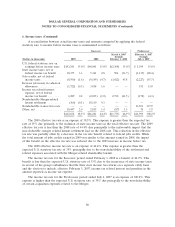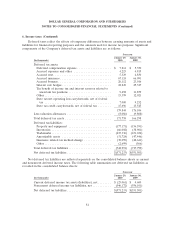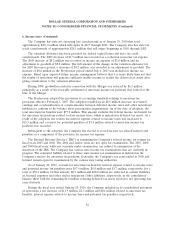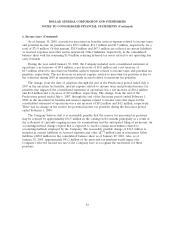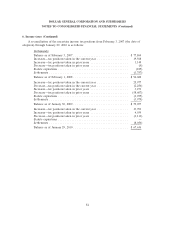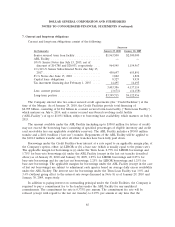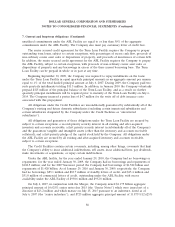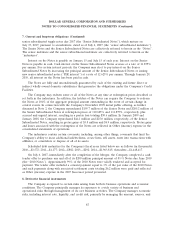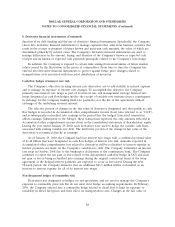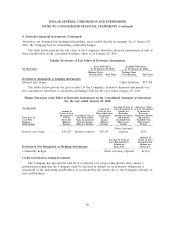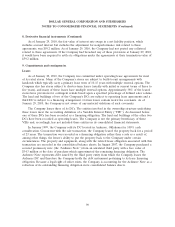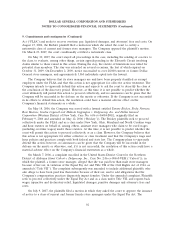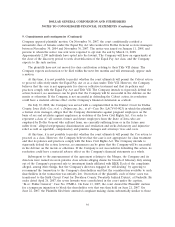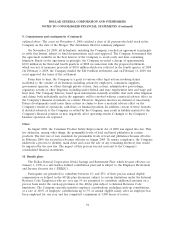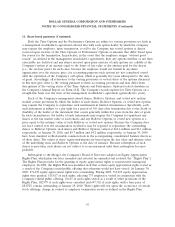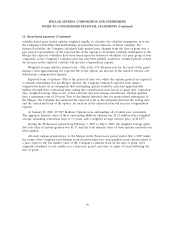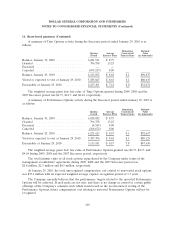Dollar General 2009 Annual Report Download - page 101
Download and view the complete annual report
Please find page 101 of the 2009 Dollar General annual report below. You can navigate through the pages in the report by either clicking on the pages listed below, or by using the keyword search tool below to find specific information within the annual report.DOLLAR GENERAL CORPORATION AND SUBSIDIARIES
NOTES TO CONSOLIDATED FINANCIAL STATEMENTS (Continued)
8. Derivative financial instruments (Continued)
As of January 29, 2010, the fair value of interest rate swaps in a net liability position, which
includes accrued interest but excludes the adjustment for nonperformance risk related to these
agreements, was $59.2 million. As of January 29, 2010, the Company had not posted any collateral
related to these agreements. If the Company had breached any of these provisions at January 29, 2010,
it would have been required to settle its obligations under the agreements at their termination value of
$59.2 million.
9. Commitments and contingencies
Leases
As of January 29, 2010, the Company was committed under operating lease agreements for most
of its retail stores. Many of the Company’s stores are subject to build-to-suit arrangements with
landlords which typically carry a primary lease term of 10-15 years with multiple renewal options. The
Company also has stores subject to shorter-term leases (usually with initial or current terms of three to
five years), and many of these leases have multiple renewal options. Approximately 38% of the leased
stores have provisions for contingent rentals based upon a specified percentage of defined sales volume.
The land and buildings of two of the Company’s DCs are subject to operating lease agreements and a
third DC is subject to a financing arrangement. Certain leases contain restrictive covenants. As of
January 29, 2010, the Company is not aware of any material violations of such covenants.
The Company leases three of its DCs. The entities involved in the ownership structure underlying
these leases meet the accounting definition of a Variable Interest Entity (‘‘VIE’’). As discussed below,
one of these DCs has been recorded as a financing obligation. The land and buildings of the other two
DCs have been recorded as operating leases. The Company is not the primary beneficiary of these
VIEs and, accordingly, has not included these entities in its consolidated financial statements.
In January 1999, the Company sold its DC located in Ardmore, Oklahoma for 100% cash
consideration. Concurrent with the sale transaction, the Company leased the property back for a period
of 23 years. The transaction was recorded as a financing obligation rather than a sale as a result of,
among other things, the lessor’s ability to put the property back to the Company under certain
circumstances. The property and equipment, along with the related lease obligation associated with this
transaction are recorded in the consolidated balance sheets. In August 2007, the Company purchased a
secured promissory note (the ‘‘Ardmore Note’’) from an unrelated third party with a face value of
$34.3 million at the date of purchase which approximated the remaining financing obligation. The
Ardmore Note represents debt issued by the third party entity from which the Company leases the
Ardmore DC and therefore the Company holds the debt instrument pertaining to its lease financing
obligation. Because a legal right of offset exists, the Company is accounting for the Ardmore Note as a
reduction of its outstanding financing obligation in its consolidated balance sheets.
90


